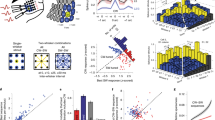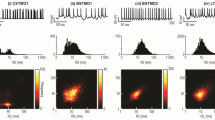Abstract
THE remarkable ability of certain higher order insect visual neurones to discriminate between movement of a small object or target and a large textured background has been clearly demonstrated by Palka1,2 and O'Shea and Fraser-Rowell3. In addition, movement of a large textured background such as a windmill pattern is inhibitory to detection of motion of a small target by this neurone, known as the descending contralateral movement detector (DCMD). The response of this identifiable neurone to motion of small objects is inhibited by rotation of the windmill pattern over a specific range of high spatial frequencies of the pattern, but is augmented by low spatial frequencies in the pattern. For this neurone we have quantitatively determined the spatial frequency at which the effect of the windmill pattern becomes inhibitory.
This is a preview of subscription content, access via your institution
Access options
Subscribe to this journal
Receive 51 print issues and online access
$199.00 per year
only $3.90 per issue
Buy this article
- Purchase on Springer Link
- Instant access to full article PDF
Prices may be subject to local taxes which are calculated during checkout
Similar content being viewed by others
References
Palka, J. J. exp. Biol. 50, 723–732 (1969).
Palka, J. Am. Zool. 12, 497–505 (1972).
O'Shea, M. & Fraser-Rowell, C. H. Nature 254, 53–55 (1975).
Fraser-Rowell, C. H., O'Shea, M., Williams, J. L. D. J. exp. Biol. 68, 157–185 (1977).
Palka, J. J. Insect Physiol. 13, 235–248 (1967).
Kien, J. in The Compound Eye and Vision of Insects (ed. Horridge, G. A.) 410–422 (Oxford University Press, Oxford, 1975).
Palka, J. & Pinter, R. B. in The Compound Eye and Vision of Insects (ed. Horridge, G. A.) 321–337 (Oxford University Press, Oxford, 1975).
Horridge, G. A., Scholes, J. H., Shaw, S. & Tunstall, J. in The Physiology of the Insect Central Nervous System (eds Treherne, J. E. & Beament, J. W. L.) 165–202 (Academic London, 1965).
Meinertzhagen, I. Phil. Trans. R. Soc. B. 274, 555–596 (1976).
Arnett, D. W. J. Neurophys. 35, 429–444 (1972).
Strausfeld, N. J. & Campos-Ortega, J. A. Science 195, 894–897 (1977).
Brooks, B. A. & Fuchs, A. F. Vision Res. 15, 1389–1398 (1975).
Mateef, S., Yakimoff, N. & Mitrani, L. Vision Res. 16, 489–492 (1976).
Author information
Authors and Affiliations
Rights and permissions
About this article
Cite this article
PINTER, R. Visual discrimination between small objects and large textured backgrounds. Nature 270, 429–431 (1977). https://doi.org/10.1038/270429a0
Received:
Accepted:
Issue Date:
DOI: https://doi.org/10.1038/270429a0
This article is cited by
-
Identified target-selective visual interneurons descending from the dragonfly brain
Journal of Comparative Physiology A (1986)
-
Adaptation of spatial modulation transfer functions via nonlinear lateral inhibition
Biological Cybernetics (1985)
-
Object- and self-movement detectors in the ventral nerve cord of the dragonfly
Journal of Comparative Physiology ? A (1981)
Comments
By submitting a comment you agree to abide by our Terms and Community Guidelines. If you find something abusive or that does not comply with our terms or guidelines please flag it as inappropriate.



